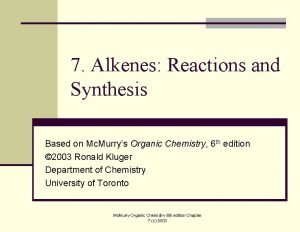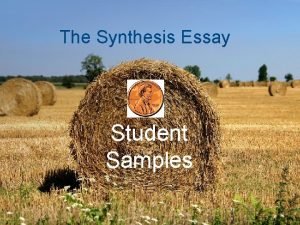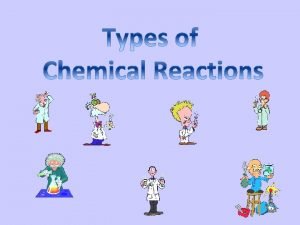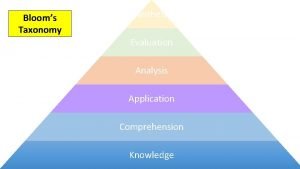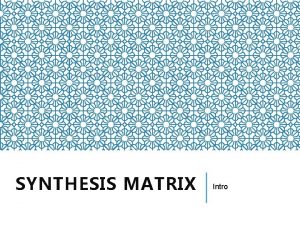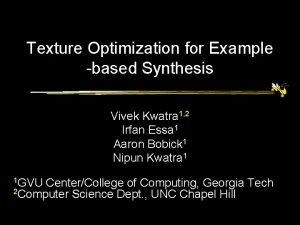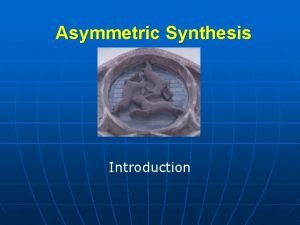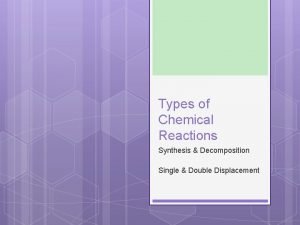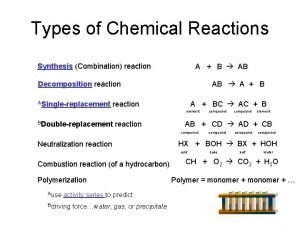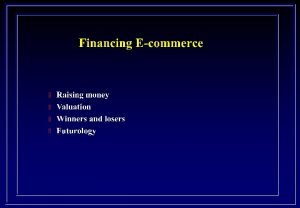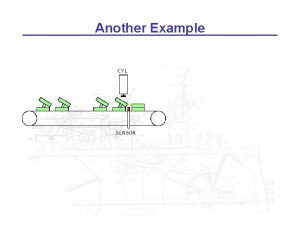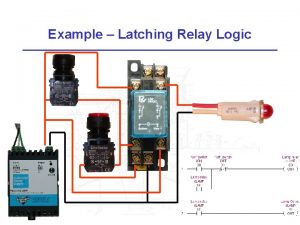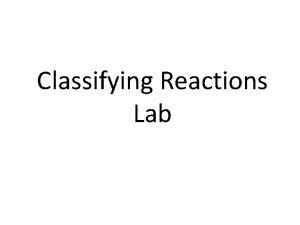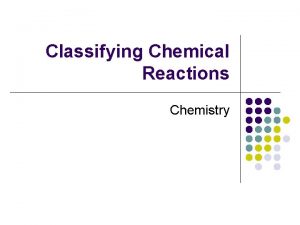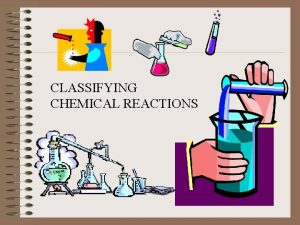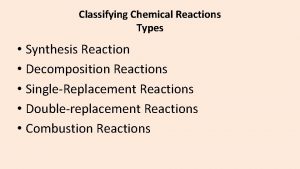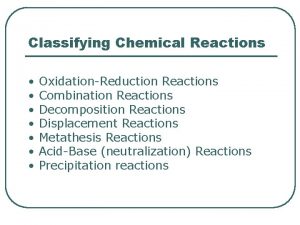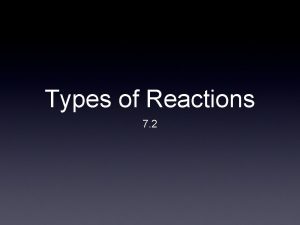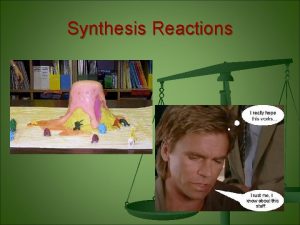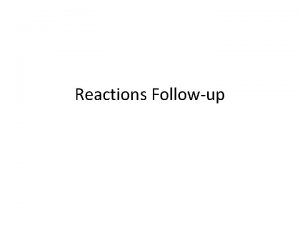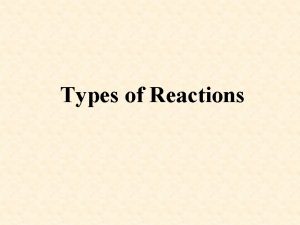CLASSIFYING REACTIONS Synthesis Reactions Here is another example




















- Slides: 20

CLASSIFYING REACTIONS

Synthesis Reactions • Here is another example of a synthesis reaction

1. Synthesis reactions • • Synthesis reactions occur when two substances (generally elements) combine and form a compound. (Sometimes these are called combination or addition reactions. ) reactant + reactant 1 product Basically: A + B AB • • Example: 2 H 2 + O 2 2 H 2 O Example: C + O 2 CO 2

Practice • Predict the products. Write and balance the following synthesis reaction equations. Sodium metal reacts with chlorine gas • Solid Magnesium reacts with fluorine gas • Aluminum metal reacts with fluorine gas •

Practice • • H Predict the products. Write and balance the following synthesis reaction equations. Sodium metal reacts with chlorine gas 2 Na(s) + Cl 2(g) 2 Na. Cl Solid Magnesium reacts with fluorine gas Mg(s) + F 2(g) Mg. F 2 Aluminum metal reacts with fluorine gas 2 Al(s) + 3 F 2(g) 2 Al. F 3

Practice • • Predict the products. Write and balance the following synthesis reaction equations. Sodium metal reacts with chlorine gas Na(s) + Cl 2(g) Na. Cl Solid Magnesium reacts with fluorine gas Mg(s) + F 2(g) Mg. F 2 Aluminum metal reacts with fluorine gas Al(s) + F 2(g) Al. F 3

Decomposition Reactions • Another view of a decomposition reaction:

2. Decomposition Reactions • • • Decomposition reactions occur when a compound breaks up into the elements or in a few to simpler compounds 1 Reactant Product + Product In general: AB A + B Example: 2 H 2 O 2 H 2 + O 2 Example: 2 Hg. O 2 Hg + O 2

2. Decomposition Reactions • • • Decomposition reactions occur when a compound breaks up into the elements or in a few to simpler compounds 1 Reactant Product + Product In general: AB A + B Example: 2 H 2 O 2 H 2 + O 2 Example: 2 Hg. O 2 Hg + O 2

Practice Decomposition • • • Predict the products. Then, write and balance the following decomposition reaction equations: Solid Lead (IV) oxide decomposes Pb. O 2(s) Aluminum nitride decomposes Al. N(s)

Practice • • • Predict the products. Then, write and balance the following decomposition reaction equations: Solid Lead (IV) oxide decomposes Pb. O 2(s) Pb + O 2 Aluminum nitride decomposes 2 Al. N(s) 2 Al + N 2

Single Replacement Reactions • Another view:

Single Replacement Reactions • • Write and balance the following single replacement reaction equation: Zinc metal reacts with aqueous hydrochloric acid 2 Note: Zinc replaces the hydrogen ion in the reaction

Single Replacement Reactions Write and balance the following single replacement reaction equation: • Zinc metal reacts with aqueous hydrochloric acid Zn + 2 HCl Zn. Cl 2 + H 2(g) 2 (aq) Note: Zinc replaces the hydrogen ion in the reaction •

4. Double Replacement Reactions • • • Double Replacement Reactions occur when a metal replaces a metal in a compound a nonmetal replaces a nonmetal in a compound Compound + compound product + product AB + CD AD + CB

Practice • 1. 2. 3. 4. 5. 6. Predict the products. Balance the equation HCl(aq) + Ag. NO 3(aq) Ca. Cl 2(aq) + Na 3 PO 4(aq) Pb(NO 3)2(aq) + Ba. Cl 2(aq) Fe. Cl 3(aq) + Na. OH(aq) H 2 SO 4(aq) + Na. OH(aq) KOH(aq) + Cu. SO 4(aq)

Practice • 1. 2. 3. 4. 5. 6. 7. Predict the products. Balance the equation HCl(aq) + Ag. NO 3(aq) Ag. Cl + HNO 3 Ca. Cl 2(aq) + Na 3 PO 4(aq) Na. Cl + Ca 3 (PO 4)2 Pb(NO 3)2(aq) + Ba. Cl 2(aq) Ba (NO 3)2 +Pb Cl 2 Fe. Cl 3(aq) + Na. OH(aq) Na. Cl + Fe(OH)3 H 2 SO 4(aq) + Na. OH(aq) Na 2 SO 4(aq) + HOH(aq KOH(aq) + Cu. SO 4(aq) Cu(OH)(aq) + K 2 SO 4(aq Balance the eqations!

Practice • 1. 2. 3. 4. 5. 6. 7. Predict the products. Balance the equation HCl(aq) + Ag. NO 3(aq) Ag. Cl + HNO 3 3 Ca. Cl 2(aq) + 2 Na 3 PO 4(aq) 6 Na. Cl + Ca 3 (PO 4)2 Pb(NO 3)2(aq) + Ba. Cl 2(aq) Ba (NO 3)2 +Pb Cl 2 Fe. Cl 3(aq) + 3 Na. OH(aq) 3 Na. Cl + Fe(OH)3 H 2 SO 4(aq) + 2 Na. OH(aq) Na 2 SO 4(aq) +2 HOH(aq 2 KOH(aq) + Cu. SO 4(aq) Cu(OH)(aq) + K 2 SO 4(aq Balance the eqations!

Mixed Practice • 1. 2. 3. 4. State the type, predict the products, and balance the following reactions: Ba. Cl 2 + H 2 SO 4 Zn + Cu. SO 4 Cs + Br 2 Fe. CO 3

Mixed Practice • 1. 2. 3. 4. State the type, predict the products, and balance the following reactions: Ba. Cl 2 + H 2 SO 4 2 HCl +Ba. SO 4 Zn + Cu. SO 4 Cu + Zn. SO 4 Cs + Br 2 Cs. Br CS 2 C + S
 Section 2 classifying chemical reactions
Section 2 classifying chemical reactions Section 2 classifying chemical reactions
Section 2 classifying chemical reactions Diol formation from alkene
Diol formation from alkene Synthesis reaction predicting products
Synthesis reaction predicting products Another place another time harris burdick
Another place another time harris burdick There's a place where streams of grace
There's a place where streams of grace Reduction half reaction
Reduction half reaction Chemical reactions section 3 reactions in aqueous solutions
Chemical reactions section 3 reactions in aqueous solutions Chemistry unit 5 reactions balancing reactions worksheet
Chemistry unit 5 reactions balancing reactions worksheet Synthesis essay example college board
Synthesis essay example college board Combustion reaction cartoon
Combustion reaction cartoon Synthesis question example
Synthesis question example Synthesis of literature example
Synthesis of literature example Synthesis matrix example
Synthesis matrix example Application synthesis
Application synthesis Synthesis matrix example
Synthesis matrix example Vivek kwatra
Vivek kwatra Asymmetric synthesis example
Asymmetric synthesis example Decomposition chemistry
Decomposition chemistry Photosynthesis decomposition reaction
Photosynthesis decomposition reaction Thesis antithesis synthesis example
Thesis antithesis synthesis example


